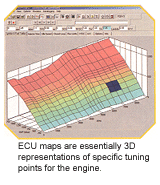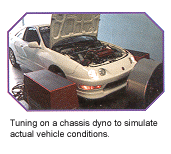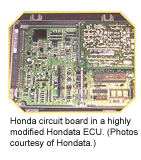It’s been called the brain and, essentially, that’s what it is. But it can be confusing what to call engine management systems these days because they are called so many things: engine control units (ECU), powertrain control units (PCM) or onboard diagnostic systems (OBD). Until recently, the “brain” was a locked box, only to be touched by OEM hands.
For the most part, these brains have been pretty good at achieving their objectives under normal operating conditions. The conditions the brain typically controls are timing, fuel, boost (if applicable) and a whole host of other things from the emissions system, ABS and electronic transmission control to the new “fly-by-wire” throttle control available in some new models.
In this article, we’ll take a look at tuning ECUs on the performance level. It may be a stretch to say that all engine techs are going to flock to tuning ECUs, but for those repair shops looking to add more services, performance “chip” tuning may be an option. Several tuners have pointed to the fact that carburetors are going “the way of the dinosaur” and that engine specialists should start now to build their understanding of these systems.
Compared to the carburetor, the simplest engine management system coupled with electronic fuel injection (EFI) can have far greater control over an engine’s functions. In fact, most engine management systems can make 10,000 or more individual adjustments for each second the engine is in operation.
If you have seen a carbureted motor on a racecar – every time the weather changed you had to change the jets. The same thing holds true with a fuel injected motor, only it’s just that it is happening electronically.
One argument for techs to learn about chip tuning is that it may be necessary to remap the ECU in order to achieve the full benefit of a monster horsepower engine build. In fact, many people are starting to realize that the ECU is power. For example, the BMW F1 engine wouldn’t be able to make, or use, 900 hp in a normally aspirated motor without an excellent ECU.
Chip Basics
Before we get into talking about the three different categories of chip tuning, there are a few things to understand about how the engine management computer functions.
With a stock ECU, the manufacturer develops a map that is a compromised setting between all of the factors a manufacturer has to contend with. Typically, only two maps affect the performance of an engine – an ignition map and a fuel map – unless it is turbocharged, then there is a boost map as well.
For the most part, ‘chipping’ is limited to OBD I vehicles. It doesn’t mean you can’t chip OBD II vehicles, but it mostly covers OBD I.
The reason it is called chipping is because these ECUs came with an Amtel chip. It is a generic chip. It’s not a flash system either: You use a chip burner and burn the information directly onto the chip.
Once you get into OBD II vehicles, you’ll find you have to reflash the chips because these systems store information on a microprocessor. The reason here is that the chips serialize themselves so that they cannot be copied and put into multiple cars. This provides copyright protection for the chip tuner on OBD II-type EPROMs.
Factory ECUs, according to several tuners, are surprisingly very good. However, they were not designed to do what tuners often want them to do. Often when the stock computer was originally programmed, it was told it would see ‘X’ amount of maximum boost, and when it sees more than that, it doesn’t know what to do, so it turns a light on.
ECUs make a three-dimensional “map” to monitor engine performance. Each map consists of a spreadsheet-like table that designates how much fuel, timing and boost (if applicable), as well as other computer functions such as VTEC switchover points, should be used at a specific rpm and load. Factory maps are designed to trip a light anytime the inputs go outside of the values listed in the tables.
Replacement Chips
There are many companies making replacement chips that are modified, but are not tuned to an individual car. The lower end of the chip spectrum tends to not show much performance gain, and may, in fact, cause the engine to lose power and throw the fuel economy off as well.
A slightly modified chip may have rev limiters raised or removed. Some chip manufacturers will remove speed governors, if there are any. And, according to a couple of tuners we spoke with, these types of chips are programmed to dump fuel and add timing onto the stock maps.
However, some chips are designed for specific modifications such as cold air intakes and free-flow exhaust systems and can show significant improvements over stock. But they will probably never be able to get the maximum performance out of a vehicle’s setup because these generic chips aren’t tuned with all of the variables unique to a specific car.
An engine tech can install this type of chip without having to use a dyno or learning to program a map. Some chip companies can even work with your specific modifications to help design a map for you.
Piggybacking
There is only a handful of companies offering piggyback computers in the U.S. right now, but they’re becoming a popular choice among people who do both street and track driving. Essentially, a piggyback intercepts all of the signals going between the ECU and the engine control sensors. The signals are then manipulated in the piggyback computer to send one set of signals to the engine and another (stock map) to the ECU. By doing this, the piggyback can remap the ECU without triggering a “check engine” light.
 One of the benefits of a piggyback over a stand-alone system is that it uses the stockmaps and simply modifies them. Therefore, you can keep the stock idle control and other settings you may want. These systems usually employ fairly detailed mapping features. For example, one manufacturer has a chip available that has two ignition maps so that one can be set for a racing fuel when you are at the track, the other set for the street. It can be switched between the two with a simple toggle switch.
One of the benefits of a piggyback over a stand-alone system is that it uses the stockmaps and simply modifies them. Therefore, you can keep the stock idle control and other settings you may want. These systems usually employ fairly detailed mapping features. For example, one manufacturer has a chip available that has two ignition maps so that one can be set for a racing fuel when you are at the track, the other set for the street. It can be switched between the two with a simple toggle switch.
This is because ECU maps are tuned for two different settings: open loop and closed loop, which can be vastly different from each other.
“Open loop” is for full-throttle applications. In this mode, the O2 sensors are basically ignored and the fuel map is considerably richer for more power at wide-open throttle (WOT). For racing applications, this area is tuned the most. Open loop is also for cold engine operation as well as WOT. The ECU will remain in open loop until the coolant sensor tells it the engine has reached a certain temperature and the O2 sensor is hot enough to generate a good signal.
 “Closed loop” is controlled by the feedback from the O2 sensors sending signals to the ECU, autotuning itself. On stock systems, these are generally good because manufacturers work hard to get the maximum fuel economy with the lowest emissions. Closed loop covers basically everything, but full throttle.
“Closed loop” is controlled by the feedback from the O2 sensors sending signals to the ECU, autotuning itself. On stock systems, these are generally good because manufacturers work hard to get the maximum fuel economy with the lowest emissions. Closed loop covers basically everything, but full throttle.
One of the differences between the piggybacks and the stand-alones is that stand-alones have been, until recently, primarily for racing applications. And, in a racing environment, correction factors are not programmed into the system. Typically, the maps are only programmed for open loop and factors like humidity and altitude at the track are programmed for that particular day.
Piggybacks, however, work in conjunction with the factory maps. It will remember, until it is reprogrammed, that it needs two degrees more than what the stock ECU says it needs.
There’s a Change in the Air
Say you drive to Denver to go to an autocross event. Because of the altitude and temperature changes, the stock ECU now determines that it needs 25 of advance. You still need to add two degrees to the 25 for a total of 27 because you’re tuning for the differential that the car needs from the stock map.
 One of the difficulties with getting a stand-alone to run well for the street and the track is keeping within a certain temperature range. If you’re within 10 C (50 F) or so, you’ll be alright, you’ll make decent power. But if you design a map for 0 C (32 F) and you’re running it at 40 C (104 F), it’s not going to run very well. And what that really translates to is a car that is not a daily-driver/autocross-friendly type of vehicle. It’ll run great at wide-open throttle, but it isn’t going to want to run when it goes to the street.
One of the difficulties with getting a stand-alone to run well for the street and the track is keeping within a certain temperature range. If you’re within 10 C (50 F) or so, you’ll be alright, you’ll make decent power. But if you design a map for 0 C (32 F) and you’re running it at 40 C (104 F), it’s not going to run very well. And what that really translates to is a car that is not a daily-driver/autocross-friendly type of vehicle. It’ll run great at wide-open throttle, but it isn’t going to want to run when it goes to the street.
The stand-alones also may be a bit too expensive for the dual-use type of customer who may not need it. These systems can run $3,500 just for the hardware. Add the tune and installation cost and one of these systems will probably end up costing $5,000 overall. They tend to work well within the limits of what you want them to do, especially if what you want them to do is race oriented.
Stand-alones
The programmable stand-alone ECU has gotten to the point where it’s almost ridiculous – there’s almost as many companies making these units as there are companies making chips. The stand-alones also are more complicated. About 95% of them don’t have a base map to start with, which means you have to kind of know what your trigger angle is, and you have to know when certain events are happening.
For example, when is the TDC Hall effect signal happening so you can get the engine to fire right? Once you figure that out, you have to look at how many milliseconds do you want to hold the injector open at 1,000 rpm? And that may be just to get it to idle. What’s it going to take at full throttle?
As you see, there are countless calculations you have to make in order to get it to even run. It’s sort of like someone giving you a new computer with nothing on it. However, you have to load everything and it is complicated, but also more flexible in what it can do.
Which is why some stand-alones have now started to include a basic set of maps as a starting point.
“Dyno Might”
Another important element to the ECU tuner is the dyno. Chassis dynos are critical in allowing the tuner to setup the ECU properly. There are two types of chassis dynos: a load dyno and an inertia dyno. For engine builders who want to think about ECU tuning, there is a critical difference between these two types of dynos.
An inertial dyno is basically just a couple of drums that the car sits on. When you push the throttle, it accelerates. A loading dyno is equipped with some kind of mechanism that will apply a load to the rollers and will allow you to stabilize the car at a given point.
Many engine builders have dynos today, but many of them are using engine dynos, which are great for most engine builders’ purposes. You can tune the ECU to a certain degree on an engine dyno, but there are differences between dyno capabilities; engine dynos can’t simulate as closely how the total package is performing. Typically, an engine dyno is set up in a climate-controlled room, and you can’t simulate the same drivetrain losses as a chassis dyno can.
When the vehicle goes on the dyno, the tuner runs the car up to the 4,200 rpm load point. On some piggybacks and stand-alones, there are at least 16 individual tuning points with 16 tuning points in between for a total of 256 tuning points. The tuner then increases the load on the inertial dyno so it reads 4,200 rpm at full throttle and adjusts the ECU at that point. The air/fuel ratio will be set, and the ignition map will be set to the optimum timing for that point. Then, the tuner will go to the next load point, which we’ll say is 4,800 rpm, and do the same thing. This is what is called “real-time” tuning.
Tuning in “real-time” on an inertial dyno is critical in being able get every ounce of performance from the engine and ECU combination.
For performance engine specialists, there is no denying that the carburetor’s days are numbered. The ECU can do thousands of “tune-ups” for every second the engine is running. And with a computer, tuners can more accurately tune to the conditions and make drastic changes without much more than a few keystrokes.
More street rods, and especially the sport compact crowd, are tuning electronically than ever before. Several racing series now allow some form of EFI, which means there is an ECU that will, no doubt, need to be tuned by someone. And that someone could be you.


